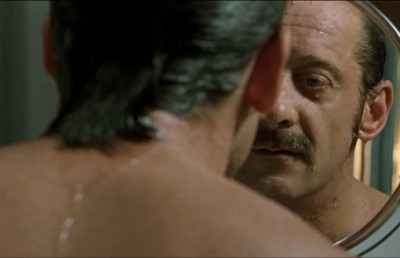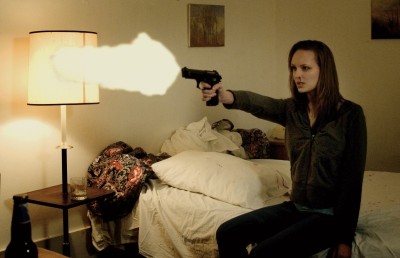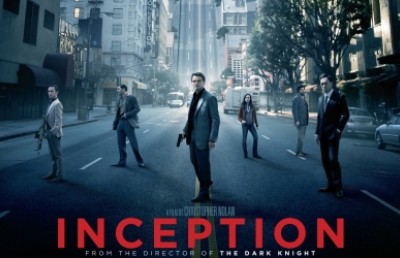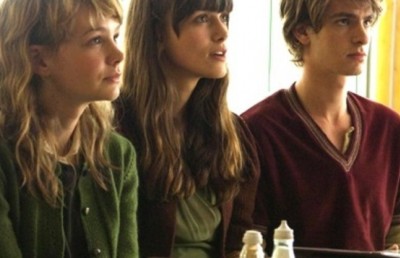A novel telling in The Limey: Non-continuity montage in mainstream American cinema
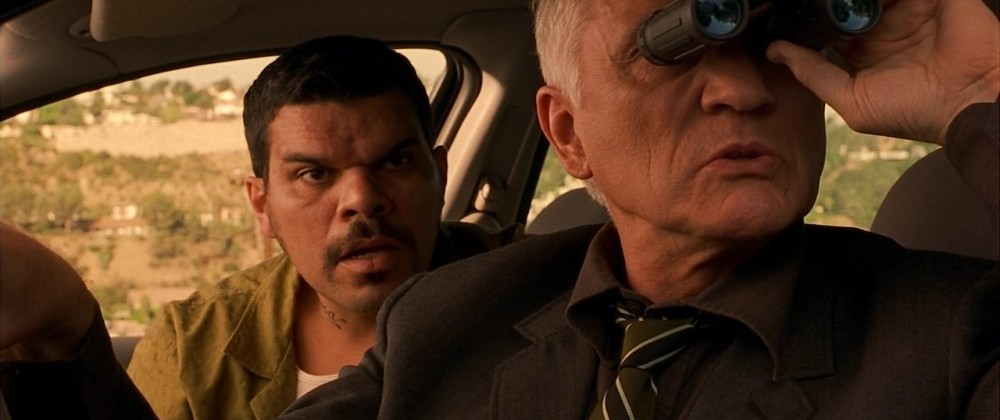
This paper applies language-based narratology and Sarah Kozloff’s thesis on voice-over narration to analyze an unconventional narrational strategy in The Limey (Soderbergh, 1999). This Hollywood genre film presents a straight-forward revenge plot, but uses an expositional montage technique that eschews continuity editing (Bordwell and Thompson 231); I shall use the term “non-continuity montage” to describe it. In its story about an ex-con who seeks out and later confronts his daughter’s killer, this film de-prioritizes the narrative coherence and clarity of Classical Hollywood Cinema in a number of temporally-dubious montage sequences that display a pensive-looking protagonist presumably deep in self-reflection. The typical viewer is initially confused by the lack of temporal order in the montage – one might ask oneself, “are we seeing shots from the past or the future?” – but quickly learns to grasp the narration upon repetitions of this unorthodox approach. I shall explain that this unusual cinematic storytelling is successful in facilitating narrative comprehension, and analyzable via Kozloff’s writings on voice-over narration in American fiction film. Furthermore, narratology, largely drawn from Gérard Genette, Mieke Bal, and Seymour Chatman, will provide a supporting framework for my analysis of the narrator, the image-maker (or implied author), and ??The Limey??’s attempt at both showing and telling. Moreover, in my analysis, I will make direct references to frames within a montage sequence that are included in the appendix (Figures 1 through 4). In light of the bold and conspicuous film style employed in this film, my conclusion will argue for the film’s trans-medium experiment in literary narration.
The curious case of The LimeyThe narration in The Limey – as early as a montage sequence following the pop music that accompanies the opening credits – appears to be a flurry of memories and subjective character perceptions. A term such as “internal focalization” (Genette 189) or Chatman’s ‘filter,’ where “[t]he story is narrated as if the narrator sat somewhere inside or just this side of a character’s consciousness…” (143), seems applicable to these sequences. But, are we merely privileged to character experience of the diegesis or is there more? The viewers’ incomplete inference of character subjectivity probably arises from the juxtaposition of shots of the protagonist Wilson (Terence Stamp) from various yet-to-be-specified temporal locations and shots of yet-unknown characters that could conceivably represent Wilson’s mental pictures. However, upon closer inspection, this early non-continuity montage sequence features not only analepses (i.e., flashbacks) but prolepses (i.e., flashforwards) to Wilson’s return flight to England at the end of the discourse. In Figure 1, these proleptic flashes occur in shots F and L. Shot F likely triggers confusion in the viewer as he/she learns the loose logic of the filmmakers’ non-continuity sequence, which will be useful for comprehending their recurrence later in the film. By the end of this sequence, the viewer has a sense that he/she has been privileged to some of Wilson’s memories – probably a nostalgia effect when coupled with the diegetic sounds of a wind chime and Wilson’s gently humming voice [1] – but remains unsure of the meaning of some of the other images. Nevertheless, this fragmentation via jump cuts coupled with some temporally-unknown sounds create curiosity without overburdening the typical viewer with an unpalatable lack of coherence. Lee Carruthers describes this approach as a “defamiliarising strategy” (13) whereby the viewer learns to remain dynamically engaged with the narration’s fragmentary revelations that gradually supply a fuller picture of story events. In other words, these unusual montage sequences are like mini puzzles contrived to bolster audience engagement.
In their DVD audio commentary, Steven Soderbergh and his screenwriter Lem Dobbs discuss their collaborative efforts to achieve a novelty effect in an otherwise uncomplicated revenge plot. Soderbergh explains the non-continuity fragmentation as a new way of conveying narrative information (0:05:01); Dobbs cites the influence of French New Wave filmmakers Jean-Luc Godard and Alain Resnais on the film style. Soderbergh uses the term “deconstruction” (0:04:03) to describe his play with plot fragmentation. In my analysis of this fractured narration, a prominent feature is my awareness of the filmmakers’ stylistic devices; Soderbergh confirms that his stylized editing draws much attention to itself, while, hopefully, continuing to engage audiences emotionally. As it were, the boldness of the film style leaves explicit indications of the narrator [2] without doing tremendous violence to audience engagement. For example, at the end of the sequence in Figure 1, the protagonist casually looks straight into the camera (Shot T) as though communicating his awareness of the narrator; it is also interesting to suggest that the character’s look acknowledges the audiences’ gaze. Another instance of narrator awareness occurs in a long take where the camera moves forward in a handheld fashion – as though a cameraman suddenly picked up the camera and rushed forward to get a closer look at a gunman (Wilson) who has important grievances to express. These two examples are merely hints (or winks) from the filmmakers that briefly reveal the narrator. Other revelations of the narrator occur in sequences where synopsized story events and character experiences are “told” through unconventional editing and the use of sound, often asynchronously. These overview-type sequences that insinuate the manipulations of a narrator seems comparable to a form of narration in literature known as “summary” (Genette 95).
The puzzle montage in The LimeyGenette defines summary as condensed narration covering “several days, months, or years of existence, without details of action or speech” (96). He further describes it as “the connective tissue par excellence of novelistic narrative, whose fundamental rhythm is defined by the alternation of summary and scene” (97). The cinematic equivalent of the summary is the typical Hollywood montage sequence set to music that often serves as a transition between scenes, e.g., the montage in Kramer vs. Kramer (1979) of Ted Kramer (Dustin Hoffman) packing away the material possessions of his estranged wife Joanna (Meryl Streep) at the end of the first act over Purcell’s sonata for trumpet and strings in D major. In this fairly typical example of a “cinematic summary,” time passes on as Ted symbolically wraps up a chapter of his middle adulthood, and the plot action moves forward in diegetic time. Does the same thing happen in The Limey? Not exactly. As seen in Figure 1, there appears to be an overview of story events in the character’s life, but no clear temporal anchors to justify the term summary as described above. Instead of summary, perhaps ‘syllepsis’ or more precisely thematic syllepsis (Genette 85n) could better characterize this unusual montage. In his analysis of Proust, Genette argues for a narrative’s “temporal autonomy” (85) whereby the narrator may forgo chronology by grouping together events linked by thematic association or other connections besides time. In The Limey, the non-continuity montage features some shots from a temporal ‘present’ (i.e., a “now” in the context of the discourse) juxtaposed with blue-tinged external analepses (Lothe 54) (Shots J, M, N & P) and prolepses (Shots C, D, F, H, L, & Q); shots F & L are fairly distant prolepses of Wilson’s return to England. The one unifying theme appears to be Wilson’s ruminative nature or, more specifically, Wilson’s remorse for a daughter half-known even in death. Thus far, I have described this temporally-fractured montage as condensed narration that seems to organize itself thematically.
This confounding organizational pattern in The Limey also resembles a puzzle, as I had suggested in my second paragraph above. Carruthers offers an extensive description of this sequence (12), including its use of sound, and compares its “riddle-like” quality (13) with other formal structures within the film, such as Wilson’s Cockney rhyming dialogue that baffles his American interlocutors. However, Hollywood has never shied away from perplexing narration in their mainstream offerings. As David Bordwell reports, Citizen Kane (1941) and How Green Was My Valley (1941) were lively experiments in narration that heavily invested in the use of analepses (72); these films led the way to other innovative Hollywood storytelling up to the mid-1950s. Nevertheless, the studios and filmmakers were always compromising with each other to strike a balance between narrative innovation and audience comprehension. Citing an example in Charlie Kaufman’s script of Eternal Sunshine of The Spotless Mind (2004), Bordwell describes the now-historical struggles during pre-production to ensure that Kaufman’s story setup was not so opaque as to turn off the audience before the eventual narrative revelations kick in (73). Such films as Point Blank (1967) and Petulia (1968) feature unconventional narration that could conceivable be considered precursors to The Limey; Carruthers considers Petulia an important reference (18; Bordwell 75) for Soderbergh’s film and recognizes the comparisons others have made to Point Blank (9). Further, more recent films such as Pulp Fiction (1994) and Memento (2001) feature innovative storytelling that dislocates the typical presentation of cinematic space and time, e.g., scenes arranged in non-linear and reverse order. The latter, a neo-noir that features much voice-over narration as was typical in its predecessors [3] brings to mind the Chandler-esque detective mystery aspects of the noir-inflected films of the Coen brothers – which often includes voice-over narration (Wichlacz) – especially in The Big Lebowski (1998). The link I wish to make between a film like The Big Lebowski and The Limey is not the puzzle-like aspect of their narratives but the way in which they foreground an all-knowing narrator.
Omniscient montage narration in The LimeyAs it were, the cowboy narrator (Sam Elliot) in The Big Lebowski – who appears explicitly as a character to briefly but innocuously interact with the protagonist, the Dude (Jeff Bridges) – resembles the undisclosed but conspicuous narrator in The Limey who implicitly reveals itself to the audience through mise en scene, editing, and cinematography, e.g., when the handheld camera rushes forward towards the loading bay in the warehouse shootout scene. More importantly, the narrator, in its third-person capacity, provides the viewer with expositional narration through the use of non-continuity montage in the following sequences (running time duration is included in parentheses followed by their labels as Figures attached in the Appendix):
i. Montage01: Wilson reflecting in his Los Angeles hotel room (0:02:20 – 0:03:34), Fig. 1
ii. Montage02: Wilson’s early meeting with Ed Roel and revolver procuring (0:05:53 – 0:07:31), Fig. 2
iii. Montage03: Valentine’s character introduction “music video” (0:15:00 – 0:15:57), Fig. 3
iv. Montage04: Elaine’s character introduction (0:20:17 – 0:20:58) [not in Appendix]
v. Montage05: Wilson reminiscing in Big Sur (1:10:06 – 1:11:50), Fig. 4
The key in this comparison between The Big Lebowski and The Limey is their functional similarity between the use of, chiefly, voice-over narration (via dialogue or sound) in the former and the use of montage (via visuals or pictures, including music and diegetic dialogue) in the latter; they both fulfill the same role: an unconventional but ultimately coherent and lucid alternative to the traditional omniscient narrator, the authority who knows all as far as the diegesis is concerned. Put another way, both narrators are heterodiegetic (Genette 245). A key element in The Limey that elevates its montage narration as beyond mere character analepses (Wilson’s) rests on the distant prolepses of Wilson’s plane ride back to England, which occurs at the discourse’s end. Moreover, an analeptic shot of Jennifer and Ed (Figure 1, Shot P), presumably on their way to confront Valentine’s “friends” at the warehouse, further reinforces this argument by not being focalized or filtered through any of the major characters. Therefore, the non-continuity montage is not so much a summary of diegetic events as it is an utterance via editing and use of sound by the omniscient narrator to provide expositional information in an unexpectedly fragmented manner.
In the following, I offer an inelegant, but highly plausible text-based adaptation of the film narration shown in Figure 1:
This is the story of a glowering, white-haired man who arrives in a new city in search of answers – he’s a “seeker” [as the preceding opening credit pop music suggests]. His clue is a letter from Ed Roel who once wrote him about a woman’s death in a car accident on Mulholland in L.A. Is the woman his daughter? He ruminates often about her as a child. Later, on his way back to England, he will again reflect on his recent and distant past. This is a tale of regret driven by the mysteries of an untimely death.
The text-based narration above could have easily been inserted in a more conventional revenge thriller, with lesser artistic merit, to achieve viewer comprehension without the Soderberghian montage. Moreover, an important feature of this adaptation I wish to delineate is tense. Using a narratological term by Genette such as ‘order’ in the arrangement of discourse events (Henderson 56), analepses (“Ed Roel who once wrote him…”) and prolepses (“on his way back to England, he will again reflect…”) are easily located in the past and future tense, respectively. The narrational innovation in The Limey stands on its visualization of montage-based omniscient narration often relegated to the aural assertiveness of the “Voice of God” narration, which is more commonly heard in documentaries and less often in fiction films.
Sarah Kozloff proposes a narrow definition of voice-over narration as “oral statements, conveying any portion of a narrative, spoken by an unseen speaker situated in the space and time other than that simultaneously being presented by the images of the screen” (5). Neither the narrations in The Big Lebowski nor The Limey fall precisely under these requirements; the former begins with a voice-over narration, in Kozloff’s sense, but when the cowboy narrator appears as a character, it breaks from the strict definition. However, the part of the definition that remains applicable is the uttered statements that relay parts of the story, which also describes the special case of omniscient narration in The Limey. I shall explain this link by first describing William Labov’s six constitutive elements of complete narratives, which he found in his research on extemporaneous oral storytelling:
the abstract (a short summary of the story that is about to be provided);
the orientation (identification of time, place, characters, and activities);
the complicating action (the unfolding of the story’s events);
the resolution (the climax);
the evaluation (commentary elucidating the point of the story); and
the coda (an epilogue, often bridging the gap between story time and the time of narrating). (qtd. in Kozloff 3)
Using Labov’s schema to analyze the text-based adaptation of The Limey provided in the preceding paragraph, I recognize some of his narrative elements in the adaptation. The opening statement that begins with “This is the story of…” is a Labovian abstract. Other parts of statements such as “arrives in a new city” and “a letter from Ed Roel who once wrote him about a woman’s death in a car accident on Mulholland in Los Angeles” contain orientations. Further, “he’s a seeker” marks the start of a complicating action, which will gradually unfold in the subsequent scenes involving Ed and, later, the warehouse sequence. These montage-driven narrational utterances that roughly resemble Kozloff’s voice-over narration repeat themselves at least five times throughout the film – I have identified them as Montage01 through Montage05 above. Whereas the novelty in The Big Lebowski involves a voice-over narrator who waltzes into the diegesis to chat with a character, the omniscient montage sequences in The Limey narrate innovatively via the uncommon combination of various film technique, such as asynchronous diegetic sound and dialogue, jump cuts and a music video sequence (Figure 3).
There may still be an objection to all these connections I have been attempting between narration made primarily via non-continuity montage and those using “Voice of God” verbal information. One objection could come in the form of a philosophical argument about the nature of natural language versus pictorial information. In other words, text-based language can make literal statements that images cannot do with the same precision. Words and sentences are propositional, whereas pictures are not; the latter relies on aesthetic responses. For example, the main figure in Botticelli’s painting “The Birth of Venus” (c. 1480) communicates the notion of “beauty” by eliciting an aesthetic response without making a linguistic assertion. To address this potential objection, I shall restate the fact that the idea of narration itself changes the viewers’ perceptions of linguistic versus pictorial information. Jonathan Culler, through a structuralist lens, asserts that the audience have “not only unconsciously learned narrative structure, but also the rules and conditions surrounding storytelling” (qtd. in Kozloff 4). For example, the audience’s knowledge of The Limey as a fictional thriller of some sort, e.g., information on the DVD cover or in the movie trailer, tacitly informs them of the functions of the fractured montage in telling parts of the story of the eponymous hero. In short, the audience recognizes the disjointed montage as narration because of its use of tense or ordering of discourse events, their tacit knowledge about the features of storytelling and the simple awareness of watching a narrative pre-arranged and produced by filmmakers.
To sum up, the omniscient montage narration in The Limey and Kozloff’s voice-over narration share the same motivation. Both perform a storytelling function and does so heterodiegetically. Further, both play their mediating roles between the narrator and a higher level storyteller, e.g., Kozloff’s “image-maker” [4] (45), such that the gap between the two is minimized. The closeness between the two can give rise to an awareness of a teller of the story. The heavily-narrated experiment in cinematic fiction by Chris Marker called La Jetée (1963) stands as an exemplar of the elegance and versatility of voice-over narration in ‘cinematic telling.’ The ‘cinematic teller’ brings still photographs “to life” through the prominence and authority of its all-knowing voice-over narration; here, the distance between the aural narrator and the image-maker clearly approaches zero, due to its reliable “Voice of God” narration. Therefore, by drawing similarities between the montage narration in The Limey and voice-over narration, I wish to emphasize the former’s capacity for telling.
The teller in The LimeyThe concepts of showing and telling in film theory derives from the strain of literary narratology to which a scholar like Gérard Genette belongs. However, unlike literature, which tells naturally but shows only indirectly, cinema can imitate literary-type telling – sometimes awkwardly – and presumably thrives in showing. Despite the default assumption that cinema is primarily a medium more naturally equipped to show rather than tell, e.g., Tom Gunning’s assertion of “its inherent photographic tendency toward mimesis” (394), there are many examples of mainstream Hollywood films that extensively tell the viewer the information they need to comprehend the discourse. In cinema, showing is associated with pictorial composition and action, whereas telling with narration based on verbal and written presentations. For example, popular science fiction films like The Matrix (1999) and Inception (2010) contain much expositional monologues and dialogues that verbalize the information necessary for the viewer to construct the diegesis and to not violate narrative realism; the latter concept concerns “coherence and logic within a particular fictional context” (Busselle and Bilandzic 255), not verisimilitude. Though many films deftly present expositional material in a motivated fashion, e.g., a verbal utterance or exchange that could plausibly occur in reality, a more fanciful diegesis can require tedious amounts of verbal narration over the span of several scenes and in between sequences of action-driven presentation. [5] Moreover, voice-over narration offers another technique for cinematic telling through use of sound. Clearly, narrative cinema often tells. Drawing from Genette, Gunning introduces the concept of “narrativization,” which “focuses the transformation of showing into telling, film’s bending of its excessive realism to narrative purposes” (394).
Gunning offers three interrelated levels of narrative discourse for cinema: the pro-filmic, the enframed image, and the process of editing (395). The pro-filmic refers to the staging and staged materials prior to filming; the enframed image is the creation or transformation process upon filming the pro-filmic; the editing is a post-production process of juxtaposing shots that gives rise to tense, e.g., the temporal order of analepses, prolepses, and “the now.” In The Limey, two of these three levels, namely the pro-filmic and the editing, are prominently employed to tell the story. Firstly, the selection of icons of cinema and television from the 60s and 70s, such as Peter Fonda, Terence Stamp, Barry Newman and Lesley Ann Warren, furnishes the film with veteran actors (i.e., Gunning’s “staged materials”) imbued with cultural significance by association with their previous works. For American audiences, Fonda, who played one of the lead characters, Superman, in the representative counter-culture film Easy Rider (1969), brings with him the baggage of his previous film roles; it supplies his character Valentine with presence and weight. A scene in The Limey that explicitly utilizes his robust status is a verbal description of Valentine by the character Elaine (Warren): “Anyway, he took the whole 60s Southern California zeitgeist and ran with it…packaged and sold it… made out like a bandit” (The Limey). The audience could then imagine an alternative scenario where Superman lives his hippie lifestyle and later sells out to capitalism in a pursuit of financial security and hedonism. How efficiently this device establishes the film’s antagonist! On the other hand, the editing as another level of film narration has been examined above under my sub-heading “Omniscient montage narration in The Limey.” Based on Gunning’s acknowledgement of the invisible Hollywood narration, deemed “a labor of concealment, the construction of an illusion” (398), a film like The Limey falls on the opposite extreme of ‘discourse invisibility’ generally associated with the Soviet montage approach of Kuleshov/Pudovkin and Eisenstein. Though Gunning goes a little further to examine the narratee and Bordwell’s theoretical arguments against a personified “narrator” in film, I shall remain on this side of the discussion that focuses on the source (not the receiver) of narrative-driven, cinematic mass communication. In sum, I agree with Gunning that narrative films do accomplish much telling, and does so through film style or the patterned use of film technique (Bordwell and Thompson 306); in Soderbergh’s case, his film style in The Limey gives rise to an unconventional storytelling that uses, primarily, jump cuts and diegetic sound to approximate language-based narration. I shall close with one more example of narration in the film that curiously remains its singular instance of voice-over narration in Kozloff’s sense.
ConclusionWhat about the proleptic opening voice-over of Wilson’s portentous demand, “Tell me about Jenny!” that appears located temporally at the end of the discourse? [6] Because this voice-over plays on a blank movie screen – no image with which to pin down the speech maker – does it fall under Kozloff’s voice-over narration proper? I believe this brief prologue can fulfill the “voice-over” part of Kozloff’s definition, but the “narration” part requires a closer inspection. In the discussion on narrative clauses and Labov’s oral narrative research, Kozloff provides two contrasting examples of sentences where one fulfills the function of the Labovian narrative, whereas the other does not:
“I am going to go to the grocery today even if it rains,” with its future tense construction, may be a promise, a threat, or a bid for martyrdom, but does not immediately fulfill any of the functions that Labov details. On the other hand, “It was a dark and stormy night, yet I decided to go to the grocery store” not only contains a narrative clause, the beginning of the complicating action, but also presents a mini-orientation by describing the weather” (Kozloff 4).
Based on the above, Wilson’s demand is not a narrative clause, and, therefore, does not seem to narrate despite its “voice-over” presentation. Indeed, upon multiple viewings, the audience can easily recognize this picture-less but diegetic prologue as the hostile and aggrieved pronouncement by Wilson directed at Valentine during their final confrontation at a beach in Big Sur. So, it is proleptic but dubious as a voice-over narration in Kozloff’s sense.
Nevertheless, it is part of the film’s narration. A second interpretation of the role of the diegetic statement “Tell me about Jenny!” is possible: it is a Labovian ‘abstract’ that very briefly summarizes the unfolding story. It is a version of the “Let me tell you a story…” preamble by the fabulist at the campfire that also includes a Labovian ‘orientation’ through the introduction of a character named Jenny. Despite the absence of an image – the voice-over plays over a black frame – the audio provides both verbal information and hints of a location, i.e., the voice is probably located near a beach. If the audience finds the narrative information conveyed scanty, it is mainly due to its tone-setting function that favours the generation of a feeling rather than furnishing particulars. A text adaptation of this opener might be as follows:
Amid crashing ocean waves, a voice demands, “Tell me!” Then, through gritted teeth it continues, “Tell me! Tell me about Jenny!”
Further, I assert that the audience could infer its tone-conveying function, despite its lack of clarity in an initial viewing as a result of its fragmentation, i.e., the non-continuous transition to opening credits and shots of Wilson’s arrival in America. This narrational strategy that capitalizes on the use of jump cuts may not be the norm in mainstream American cinema with the exception of, say, parallel editing; the logic of parallel editing still seems easier to grasp than Soderbergh’s jump cuts because the former has been somewhat conventionalized since the time of D. W. Griffith in the early 1900s. It is, however, very common in the novel. Language-based fiction as a medium of storytelling has the fluent capacity for switching amongst several lines of action or description rather abruptly, e.g., within a single chapter, before converging to form a coherent narrative. In this way, The Limey resembles a literary-type of narration. However, The Limey is not the rare movie that tells – all narrative films do by virtue of their filmic narration. Rather, its way of telling displays a consciousness of language-based narratives. Therefore, The Limey represents an innovative attempt at trans-medium narration.
Appendix
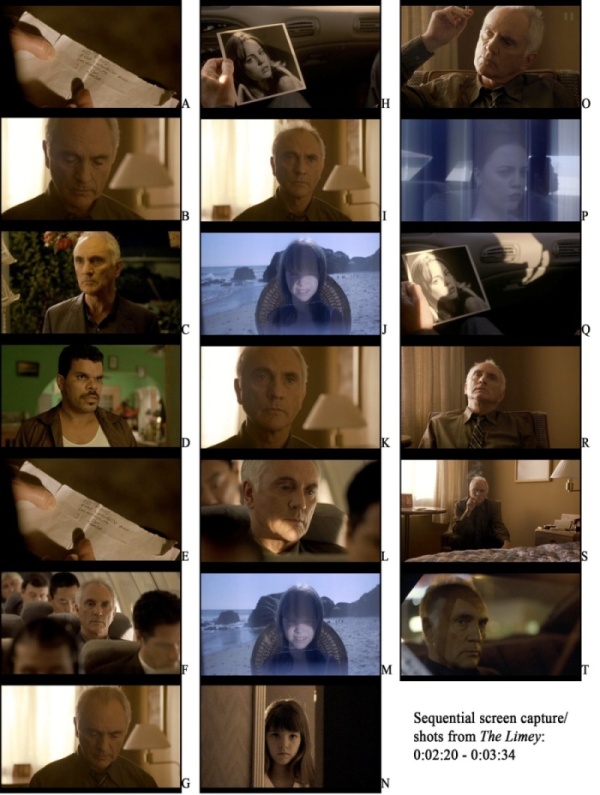
Figure 1: Montage01 from The Limey
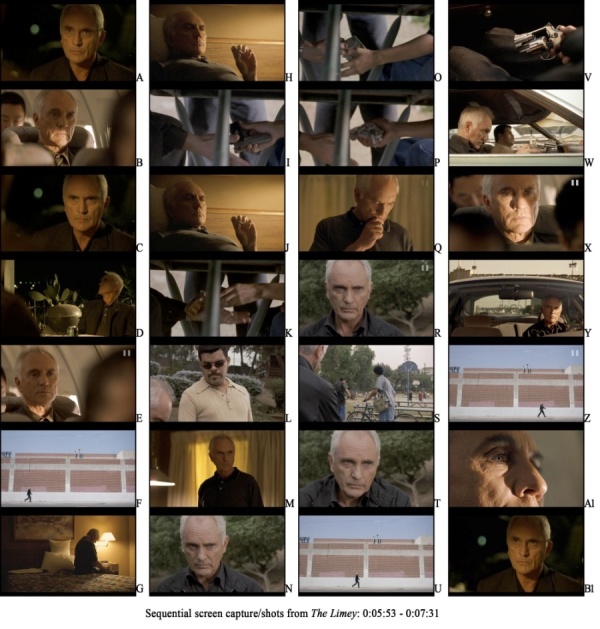
Figure 2: Montage02 from The Limey
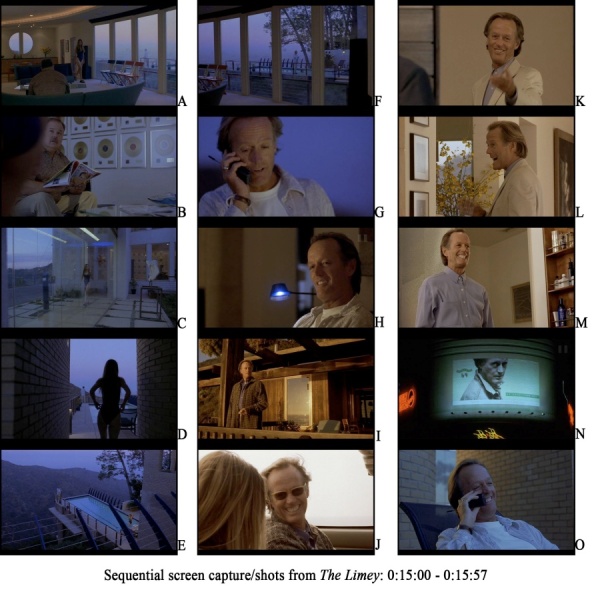
Figure 3: Montage03 from The Limey, the “music video” introduction of Terry Valentine’s character.
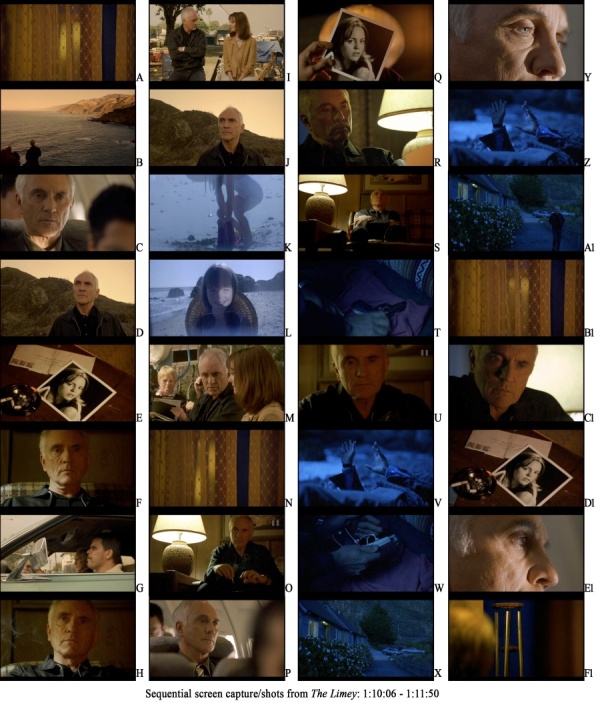
Figure 4: Montage05 from The Limey, the montage just prior to Big Sur shootout finale
Endnotes
1 The wind chime is later revealed as a diegetic sound source when it appears at the door of Wilson’s lodgings at Big Sur prior to the final showdown with Valentine (see Shot F1 in Montage05, Figure 4). The humming is probably diegetic as well.
2 “Narrative agent” for Mieke Bal (119); “a narrative instrument that the author uses to present and develop the text” for Lothe (20).
3 Kozloff explains that the noir genre embraced voice-over narration in the 1940s & 50s, along with “semi-documentaries, war films, and adaptations” (37)
4 This term is comparable to Wayne Booth’s “implied author” as used by Chatman (113) and Bal (5). Further, though the term image-maker contains a bias for visuals, Kozloff explains that it is also “the maker/conveyor of all dialogue, sound effects, and music” (45)
5 This is particularly true in Chris Nolan’s Inception (2010), where expositional information about the multi-level dreams-within-a-dream diegesis (usually conveyed through dialogue) seems to continue into the main action.
6 The voice coupled with the audible diegetic ocean waves clearly locates its narrative time at the Big Sur shootout finale where Wilson pumps an incapacitated Valentine for information surrounding Jenny’s death.
Works Cited:Bal, Mieke. Narratology: Introduction to the Theory of Narrative. Toronto: University of Toronto Press, 1985. Print.
The Big Lebowski. Dir. Joel Coen. PolyGram Filmed Entertainment. 1998. Film.
Bordwell, David. The Way Hollywood Tells it: Story and Style in Modern Movies. Berkeley:University of California Press, 2006. Print.
Bordwell, David, and Kristin Thompson. Film art: An introduction. Boston: McGraw Hill, 2008. Print.
Busselle, Rick, and Helena Bilandzic. “Fictionality and perceived realism in experiencing stories: A model of narrative comprehension and engagement.” Communication Theory 18.2 (2008): 255-280. Print.
Carruthers, Lee. “Biding our time: Rethinking the familiar in Steven Soderbergh’s The Limey.” Film Studies 9 (2006): 9-21. Print.
Chatman, Seymour Benjamin. Coming to Terms : The Rhetoric of Narrative in Fiction and Film. Ithaca, N.Y.: Cornell University Press, 1990. Print.
Eternal sunshine of the spotless mind. Dir. Michel Gondry. Universal. 2004. DVD.
Genette, Gérard. Narrative Discourse: An Essay in Method. Ithaca, N.Y.: Cornell University Press, 1980. Print.
Gunning, Tom. “Narrative discourse and the narrator system.” Film Theory and Criticism. Ed. Leo Braudy, and Marshall Cohen. New York; Oxford: Oxford university press, 2009. 390-401. Print
Henderson, Brian. “Tense, mood, and voice in film (Notes after Genette).” Film Quarterly 36.4 (1983): 4-17. Print.
Inception. Dir. Christopher Nolan. Warner Bros., 2010. Film.
La jetée. Dir. Chris Marker. Janus Films. 1963/2007. DVD.
Kozloff, Sarah. Invisible Storytellers: Voice-over Narration in American Fiction Film. Berkeley: University of California Press, 1988. Print.
The Limey. Dir. Steven Soderbergh. Artisan Entertainment, 1999. Film.
Lothe, Jakob. Narrative in Fiction and Film: An Introduction. Oxford [u.a.]: Oxford University Press, 2000. Print.
Soderbergh, Steven, dir. Lem Dobbs, wrt. The Limey. Artisan home entertainment, 2000. DVD Audio Commentary Track.
Wichlacz, Sarah. “Issues of narration: Voice-over in film”. 27 May 2006. Web. 2 Dec. 2010.



